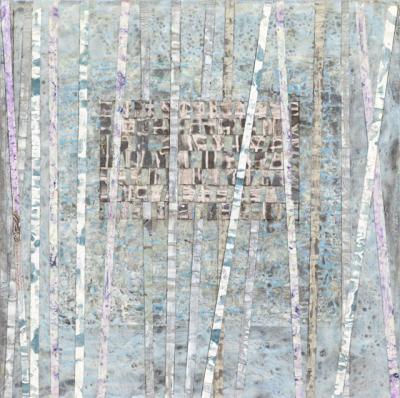Spring Sneaks Into the Drawing Room

It has been awfully hard to be excited about spring in these parts. Although the calendar says April, the wind says otherwise. Nevertheless, the Drawing Room gallery in East Hampton is celebrating the vernal equinox with a show of works loosely or directly related to the season.
The gallery’s window sets the scene, with a bouquet of outdoor scenes by Kathryn Lynch, John Alexander’s trio of mackerel, John Torreano’s column of colorful gems, a pretty alabaster sculpture by Aya Miyatake, and a single watercolor bloom by Gustavo Bonevardi.
Mr. Bonevardi’s blooms, looking like abstracted lilies and called “Compositions” with the date of their creation, seem hopeful, as their minimal color brightens up the broad expanse of the paper. There is something Asian in their modest yet perfect simplicity.
A much larger column (more than six feet high) by Mr. Torreano, with large gaudy gems, matches some of the colors in the watercolors nearby. It’s hard to tell what Hector Leonardi might be painting in his nonrepresentational canvases that still offer a hint of nature in the strips of color he collages into his work. In “Gennaio” it looks like trees in dappled sunlight with that stronger blue sky of spring.
Rounding out the front room are paintings by Robert Harms in his best spring colors in oil on linen and canvas. There are gentle blue washes and then pops of reds, yellows, and greens. But they’re a bit muddy too, very much like spring. In the largest piece, a three-foot-square canvas called “In Spring,” the dots of color with tails look like tadpoles in the water.
Laurie Lambrecht shows a set of her photo prints on linen that she hand embroiders. The subjects are tree bark, and she titles them with the location where she found them, such as “Sagg Swamp” or “Bari, Italy.” They are hung with magnets in a way that allows them to float just off the wall, giving them a satisfying presence as objects.
Another alabaster piece by Ms. Miyatake is the finishing touch. “Danmen” means cross section, and the piece has one side bluntly cut and yet perfectly polished. She finds her rough blocks in stone yards or salvages them and then grinds and polishes them to achieve their stunning surfaces. Through this she gives them a kind of rebirth, the theme heightened by their ovate shapes.
In the hallway are pieces by Ms. Lynch, Jean Pagliuso, and Fiona Waterstreet. Ms. Pagliuso’s chicken photograph, titled “White #11,” and her “Owl XV” feature her treatment of bird subjects as fashion models. Also unusual is her printing technique, which involves handmade paper brushed with silver gelatin emulsion that is both shimmering and painterly, particularly at the edges.
Ms. Waterstreet shows a suite of her porcelain bird subjects, recognizable as such but unique as well to her vision and hand. With beaks and small heads they begin to morph into abstractions in their bodies and perches. No more than six inches in height, they are pleasingly bird-sized and fascinating to behold in their various shapes and glazes.
The back room finishes off with a suite of Ms. Lynch’s window paintings, simple views out to an urban landscape with strong blue day and night skies. The loose geometry of the buildings and other structures are matched and balanced by the rectangles of window. There is something crudely satisfying about the simple blockiness of these oil-on-board paintings, like drinking something warm and comforting out of a rough stoneware mug.
By the stairs is Mr. Alexander’s “Big Rooster (Hobe Sound)” caught in midstride and looking like he might be trying to escape his frame. The pastel and watercolor-on-paper work is frank and unadorned, and the subject is set in the same kind of neutral background as Ms. Pagliuso’s birds. It’s a fitting end to a show offering all the hints of spring’s fecundity.
The exhibition will stay on view through May 7.
